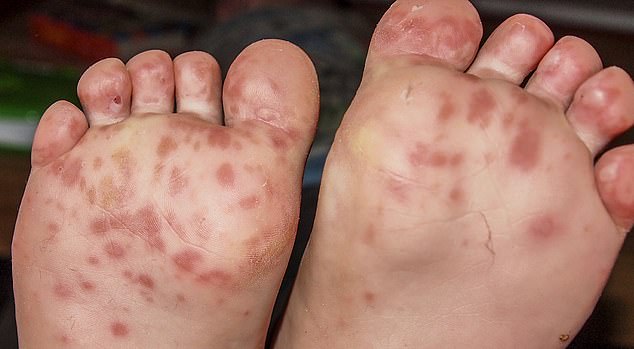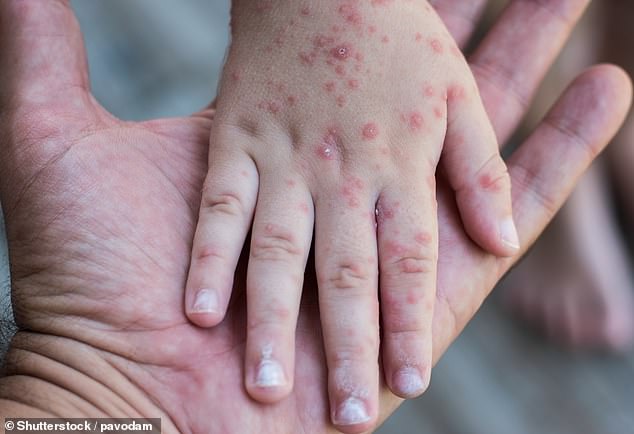Doctor warns against shopping in Goodwill bins after woman contracts ‘unbelievably’ contagious disease
A New Jersey bargain hunter claims she contracted a contagious virus from rummaging through clothing bins at thrift stores.
Sarah Smithers developed bumps and blisters on her hands days after hours of digging through the bargain bin at a Goodwill with her bare hands.
She was diagnosed with coxsackievirus, commonly known as hand, foot and mouth disease, which spreads through airborne droplets when someone coughs or sneezes.
While it sounds far-fetched, doctors and nurses said these droplets can remain on clothing for hours and then be transmitted to others who then touch their mouth or an open wound.
Experts are being warned against sifting through bins full of strangers’ unwashed clothes without washing their hands thoroughly at the end.
TikTok user Sarah Smithers contracted the coxsackie virus, commonly called hand, foot and mouth disease, after spending hours rummaging through bargain bins at a New Jersey Goodwill with her bare hands.

Hand, foot and mouth disease causes rashes and painful sores on the hands, feet and in the mouth. Sores may also appear on the buttocks, and although the rash is not itchy, it can be very painful
Sarah ventured to her local Goodwill store to wade through the bargain bins after being told by many people that she could get “so much good stuff for not much money.”
“What they don’t tell you is that you can get hand, foot and mouth disease just like me.”
Her cautionary tale led to feedback from doctors to wear gloves and wash their hands thoroughly after digging.
Contact with the saliva or feces of an infected person and then touching one’s own face, mouth, eyes, or nose can cause HFMD.
Between 10 and 15 million cases of enteroviruses, including coxsackievirus, are confirmed in the U.S. each year. Most of these are in children.
When the saliva, mucus or fluid from a sick person’s blisters comes into contact with clothing, the pathogens can linger for hours, according to California-based podiatrist Dr. Dana Brems, who responded to Mrs. Smithers’ video.
Dr. Luke Maxfield, a dermatologist based in Tennessee, said in response to Ms. Smithers’ story: “Phew, bad deal. Someone’s dirty hands touch an object, you touch the object, you touch your face, and then your hand, foot, mouth.
“There’s really no treatment, so just wash your hands.”
Dr. Myro Figure, an anesthesiologist at the University of California, Los Angeles, added: “The coxsackie virus is incredibly contagious.”
The virus can also cause flu-like symptoms such as sore throat, diarrhea, dehydration and loss of appetite.
Because it cannot be treated with antibiotics, patients must wait it out until it goes away on its own, usually seven to 10 days.

Hand, foot and mouth disease is most common in children under the age of seven. The virus has no cure and is usually gone within about a week
Dr. Meghan Martin, pediatrician in Florida, said: ‘It should actually be called hand, foot, mouth and booty disease… it causes a rash and possibly blistering on the hands, feet, around the mouth and back of the throat, and on the booty.’
The condition is most often seen in infants and young children.
Dr. Martin added: ‘The most important thing, honestly, is pain management to encourage patients to drink and stay hydrated.’
Patients with HFMD should take over-the-counter pain relievers, which will also lower their fever, such as ibuprofen or Tylenol.
Goodwill recommends on its site that shoppers wear gloves “good enough to protect against cuts and abrasions.”
The outlet adds, “Especially in this day and age, you can never be too safe. These types of stores throw stuff in the bins; broken, mounted, sharp or blunt.’
HFMD is rarely associated with serious complications, including pneumonia and inflammation in the pancreas. In very rare cases, the infection can reach the brain and cause inflammation of the protective layer surrounding the brain, called meningitis.
Nearly 13 percent of cases are asymptomatic, 86 percent are mild, one percent progress to severe or critical stages and 0.03 percent lead to death.
